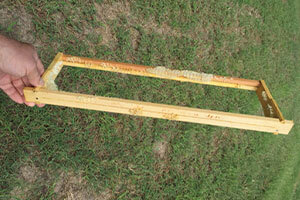
As of this writing one of my colonies collapsed with two-half filled supers of comb honey on board. The brood chamber is producing wax moths. The supers have small hive beetles in them. My solution will be to separate the boxes and let nature take its course. The brood frames will have the wired wax foundation replaced. Those frames and standard hive bodies will accept nucleus colonies or packages next spring. The fresh started package bees will get a frame of capped brood from one of my winter surviving colonies which come through strong enough to swarm. That frame of brood will triple the size of the package within a week, keep the package in the new home and make comb honey during the year installed.
My two-queen colony has recovered its strength. As of this writing, it appears to have at least three supers of honey completed. This colony has the workers to fill a super during our fall flow. Our two-queen colony experiment has been successful this season. One side became weak early with the issue of a swarm. The other side had a slow start. It seems that half of our colonies either succumb to colony collapse disorder or become weaker than we expect in the spring. Weak colonies do not make bumper comb honey crops. There is a possibility that two-queen systems will not work for comb honey production given the CCD induced by Varroa destructor. I have single colonies that have produced the same amount of supers. If both colonies in this two-queen system survive the winter, we will keep the experiment going into next spring.
The wax moths from collapsed colonies can be saved for fish bait. The reference for this recipe is in FISHING with NATURAL INSECTS by Dr. Alvah Peterson, professor of Entomology at Ohio State University. Wax moth larvae are dropped directly into boiling hot water. It is about the same as cooking a lobster. The internal tissue will coagulate and harden like a boiled egg. Larvae killed in this manner are firm and they keep better. They do not collapse when placed on a hook. For a preservative use two tablespoons of salt (sodium chloride) in a cup of water. Cooked insect larvae in this salt solution, placed in a refrigerator, will keep as long as or longer than a jar of pickles. I did this with a large number of wax moth larvae (a pint) years ago. They lasted 5 fishing seasons in a glass jar. This is a natural hive product that could be produced and sold in small (2 ounce) containers as a byproduct of beekeeping. I must admit, it does give me some pleasure of revenge to drop wax moth larvae into boiling water and pickle them.
There are two products I am using in comb honey production at this time. It would be good if both were yet available in beekeeping supply houses. The first is a comb honey wooden frame. This is a different than a regular Hoffman frame. The top bar is thin and is split down the middle. The frame can be quickly loaded with comb honey foundation. A board with two finishing nails that stick up about half an inch and spaced about ¼ inch apart will fit into the split. When the frame is turned 90 degrees, the split opens and the wax foundation can be pinched in the split. These top bars were once available from Kelley Beekeeping supply. They have quit making them. A table saw can be used to cut the top piece off of a Hoffman frame. It needs to be about ½ inch thick. A large blade miter saw with a movable arm can be used to cut the split in the middle of the top bar. If I knew where to buy these, I would put it into this article. However, I do not know anyone who makes this piece of woodenware except me at this writing. Mine are homemade sacrificing a Hoffman frame top bar. The side bars and bottom bars are the same.
This split top-bar will yield comb that is an additional ½ inch taller in a standard shallow frame. This fills up the 4 ½ inch square boxes from side to side and top to bottom. The extra honey comb will make a box of honey that weighs in at 14 ounces and maybe a pound if the cut comb is thick enough. The 4 ½ inch square hard plastic boxes make the best product. They are about $1 each, but the product is much better protected, including ant proof. You must use 10 frames per super if these boxes are used to pack the honey. If 9 frames are used, the honey will be too thick for this box. Most of my orders now are for cut comb honey in a half size box. The same company that makes the 4 ½ inch square (Pioneer Plastics) produces a box that is 2 ½ by 4 ½ inches. This increases packing by a factor of two. This box will bring a …


